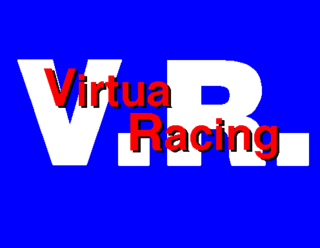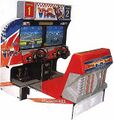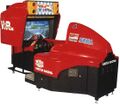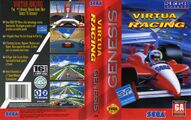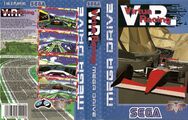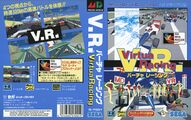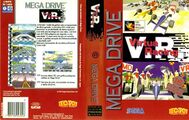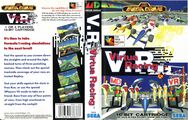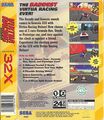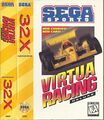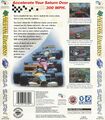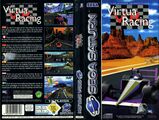Difference between revisions of "Virtua Racing"
From Sega Retro
| Line 31: | Line 31: | ||
More recently, the game has been remade as part of the [[Sega Ages 2500]] series on the [[PlayStation 2]], which includes an extra three new courses and four new cars to the Model 1 version. | More recently, the game has been remade as part of the [[Sega Ages 2500]] series on the [[PlayStation 2]], which includes an extra three new courses and four new cars to the Model 1 version. | ||
| + | |||
| + | ==Production Credits== | ||
| + | ===Arcade Version=== | ||
| + | '''Director / Chief Programmer:''' [[Yu Suzuki]]<br> | ||
| + | '''Programmers:''' Takuji Masuda, Masahiko Kobayashi, Masahiro Kawamura, Kazuhiko Yamada, Shin Kimura<br> | ||
| + | '''Chief Designer:''' [[Toshihiro Nagoshi]]<br> | ||
| + | '''Designers:''' Seiichi Ishii, Kunihiko Nakata, Toshiya Inoue<br> | ||
| + | '''Music Composer:''' [[Takenobu Mitsuyoshi]]<br> | ||
| + | '''Sound Effect:''' [[Yasuhiro Takagi]]<br> | ||
| + | '''Hardware Designers:''' Shoji Nishikawa, Keisuke Yasui<br> | ||
| + | '''Mechanical Effect Technician:''' Masaki Matsuno<br> | ||
| + | '''Electrical Technician:''' Futoshi Ito<br> | ||
| + | '''Program Supports:''' Ikuo Taniguchi, Yasuhito Shoji, Satoshi Hosoda<br> | ||
| + | '''And Our Fresh Staffs:''' Kohki Koiwa, Toru Ikebuchi, Yasuko Suzuki, Naomi Ota, Takeshi Suzuki, Yasuo Kawagoshi, Nobukatsu Hiranoya<br> | ||
| + | '''Produced by:''' [[Sega]]<br> | ||
==Gallery== | ==Gallery== | ||
Revision as of 20:51, 24 February 2012
This short article is in need of work. You can help Sega Retro by adding to it.
| Virtua Racing |
|---|
| System(s): Sega Model 1, Sega Mega Drive, Sega 32X, Sega Saturn, Sony PlayStation 2 |
| Publisher: Sega Time Warner Interactive PS1 ??? |
| Developer: Sega AM2 |
| Genre: Racing |
Virtua Racing (バーチャレーシング, also known as V.R.) is a racing game developed by Sega AM2 in 1992. It was the first game released for the Sega Model 1 arcade platform, and also the first in the "Virtua" series (it was later followed by Virtua Fighter and Virtua Cop. Initially created as proof of concept program for the system, Virtua Racing was given the all-clear to become a fully fledged arcade title and became one of the first 3D racing games to appear in arcades.
The original release of Virtua Racing has the player race formula 1 cars around three different tracks, however subsequent releases have added tracks and different types of car. The game was pioneering for the genre, but is missing numerous features considered a standard in modern day racers. There are no textured polygons as Model 1 hardware did not support them. There are also no music tracks - instead jingles of several seconds long play as the user crosses checkpoints. The game has a fairly high polygon count however, something that would not be matched by home consoles until several years down the line.
Contents
Ports and re-releases
Due to its Arcade success, Virtua Racing was ported to home consoles in the following years. The Sega Mega Drive port released in 1994 uses a custom made "Sega Virtua Processor" chip, allowing the game to render polygons similar to the Super FX chip within Star Fox for the SNES. As a result it is one of the more technically advanced Mega Drive games in the library, but the unusual specifications of the cart mean that it is often one of the first games to not be supported by cost-reduced hardware (for example, it won't work with the Genesis 3). That being said, the Mega Drive version still takes a hit in terms of graphics and sound - displaying fewer polygons at a smaller resolution with a restricted palette and lower framerate.
The Sega 32X port, released a few months later as Virtua Racing Deluxe includes two extra tracks and due to the increased power of the 32X, has a greater resemblance to the Model 1 release. Virtua Racing Deluxe adds support for "stock" and "prototype" cars too. All of the home ports include two-player modes, time trials and options usually only available to arcade operators.
A Sega Saturn release by Time Warner Interactive (initially known as Virtua Racing Saturn) appeared in 1995, sporting seven extra courses (on top of the three arcade tracks), four new cars and a grand prix mode. It borrows nothing from the 32X version and still has a lower polygon count. Also included is full motion video and a CD audio soundtrack (however it still only plays music when players pass through checkpoints).
More recently, the game has been remade as part of the Sega Ages 2500 series on the PlayStation 2, which includes an extra three new courses and four new cars to the Model 1 version.
Production Credits
Arcade Version
Director / Chief Programmer: Yu Suzuki
Programmers: Takuji Masuda, Masahiko Kobayashi, Masahiro Kawamura, Kazuhiko Yamada, Shin Kimura
Chief Designer: Toshihiro Nagoshi
Designers: Seiichi Ishii, Kunihiko Nakata, Toshiya Inoue
Music Composer: Takenobu Mitsuyoshi
Sound Effect: Yasuhiro Takagi
Hardware Designers: Shoji Nishikawa, Keisuke Yasui
Mechanical Effect Technician: Masaki Matsuno
Electrical Technician: Futoshi Ito
Program Supports: Ikuo Taniguchi, Yasuhito Shoji, Satoshi Hosoda
And Our Fresh Staffs: Kohki Koiwa, Toru Ikebuchi, Yasuko Suzuki, Naomi Ota, Takeshi Suzuki, Yasuo Kawagoshi, Nobukatsu Hiranoya
Produced by: Sega
Gallery
Screenshots
Manuals
Mega Drive Version
32X Version
- US Manual (info) ("VirtuaRacingDeluxe_32XUSManual.cbr" does not exist)
- JP Manual (info) ("Vrdeluxe 32x jp manual.cbr" does not exist)
Physical Scans
| Sega Retro Average | ||||
|---|---|---|---|---|
|
| {{|L}} | N/A |
|---|---|
| Based on 0 reviews | |
Mega Drive Version
32X Version
Saturn Version
- Stubs
- No players field
- Old content rating field
- Use romtable template
- All games
- Old-style rating (consolesplus)
- Rating without source
- Old-style rating (maniac)
- Old-style rating (joypad)
- No ratings
- 1992 Model 1 Games
- 1994 Mega Drive Games
- 1994 Sega 32X Games
- 1995 Saturn Games
- 2004 PlayStation 2 Games
- Model 1 Games
- Mega Drive Games
- Sega 32X Games
- Saturn Games
- PlayStation 2 Games
- Mega Drive Racing Games
